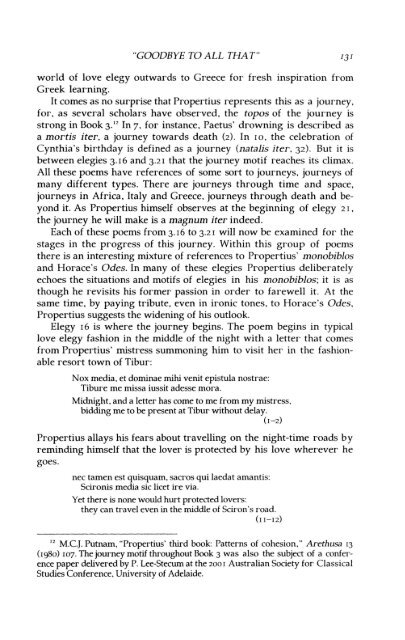OUSEION - Memorial University's Digital Archives Initiative ...
OUSEION - Memorial University's Digital Archives Initiative ...
OUSEION - Memorial University's Digital Archives Initiative ...
You also want an ePaper? Increase the reach of your titles
YUMPU automatically turns print PDFs into web optimized ePapers that Google loves.
"GOODBYE TO ALL THA T" 13 1<br />
world of love elegy outwards to Greece for fresh inspiration from<br />
Greek learning.<br />
It comes as no surprise that Propertius represents this as a journey.<br />
for. as several scholars have observed. the topos of the journey is<br />
strong in Book 3. 12<br />
In 7. for instance. Paetus' drowning is described as<br />
a mortis iter. a journey towards death (2). In ro. the celebration of<br />
Cynthia's birthday is defined as a journey (natalis iter. 32). But it is<br />
between elegies 3.16 and 3.21 that the journey motif reaches its climax.<br />
All these poems have references of some sort to journeys. journeys of<br />
many different types. There are journeys through time and space.<br />
journeys in Africa. Italy and Greece. journeys through death and beyond<br />
it. As Propertius himself observes at the beginning of elegy 2 I.<br />
the journey he will make is a magnum iter indeed.<br />
Each of these poems from 3.16 to 3.21 will now be examined for the<br />
stages in the progress of this journey. Within this group of poems<br />
there is an interesting mixture of references to Propertius' monobiblos<br />
and Horace's Odes. In many of these elegies Propertius deliberately<br />
echoes the situations and motifs of elegies in his monobiblos; it is as<br />
though he revisits his former passion in order to farewell it. At the<br />
same time. by paying tribute. even in ironic tones. to Horace's Odes.<br />
Propertius suggests the widening of his outlook.<br />
Elegy 16 is where the journey begins. The poem begins in typical<br />
love elegy fashion in the middle of the night with a letter that comes<br />
from Propertius' mistress summoning him to visit her in the fashionable<br />
resort town of Tibur:<br />
Nox media. et dominae mihi venit epistula nostrae:<br />
Tibure me missa iussit adesse mora.<br />
Midnight. and a letter has come to me from my mistress.<br />
bidding me to be present at Tibur without delay.<br />
(1-2)<br />
Propertius allays his fears about travelling on the night-time roads by<br />
reminding himself that the lover is protected by his love wherever he<br />
goes.<br />
nec tamen est quisquam. sacros qui laedat amantis:<br />
Scironis media sic licet ire via.<br />
Yet there is none would hurt protected lovers:<br />
they can travel even in the middle of Sciron's road.<br />
(lI-I2)<br />
IZ M.C}. Putnam. "Propertius' third book: Patterns of cohesion." Arethusa 13<br />
(1980) 107. The journey motif throughout Book 3 was also the subject of a conference<br />
paper delivered by P. Lee-Stecum at the 2001 Australian Society for Classical<br />
Studies Conference, University of Adelaide.

















